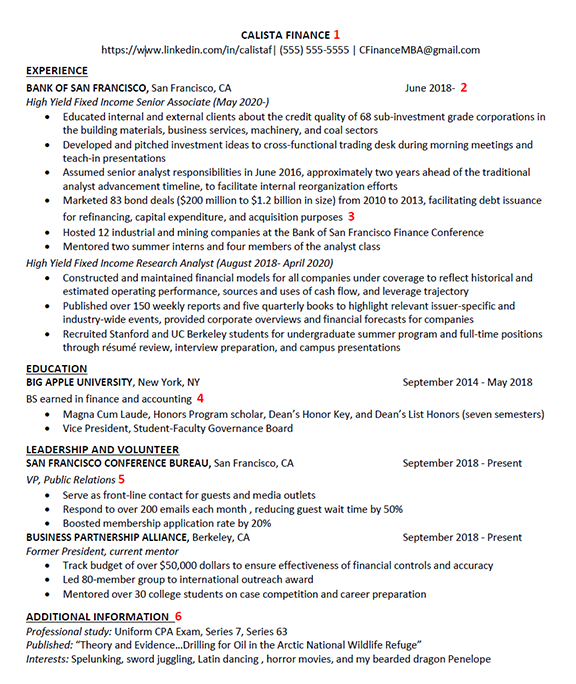An admissions resume for MBA and most master’s degree programs is not a job-hunting resume and it’s not an academic resume or CV. You don’t need to include the right buzz words or to enumerate your academic achievements.Following is the template I’ve recommended to my clients for years. It’s surprisingly versatile, albeit rather plain.

Other parts of your application provide more detailed information to admissions. So although admissions readers will look at your resume, they will not depend on it as a primary source of information.
There is no standard resume format and that’s ok. I prefer this particular style because it’s easy to scan quickly. (Key rule: always make life as easy as possible for your admissions readers. Their eyes get tired at the end of the day.) But other formats may work too. One cautionary note: keep the format clean and simple. The admissions software sometimes chokes on shadings or borders or other eye-catching adornments. This is not the place to express your creativity. Plain and simple is good. Really.
One page unless you have more than ten years of experience. Some schools require it, and even if they don’t, a resume is supposed to be a summary. Keep it succinct yet impactful. With plenty of white space and ample margins and font size 10.5 or more.
Each situation is different, but I’ve noted a few key takeaways (the following numbers correspond to the red digits on the resume!)
- Don’t waste too much precious real estate on your header. If they want to call or email you, they’ll use the contact information on your application.
- Align your dates along the right side of the resume using tabs so it’s easy for someone to get a sense of where you have been at every point in time. Ideally, the education and work sections of your resume are in reverse chronological order, giving admissions officers a quick overview.
- Quantify, quantify! What was the scope of your effort? How many people affected? Percentage increase in revenues? Number of departments involved? Marketing response rate? Size of your team? Decrease in expenses? The more concrete, the greater the impression your resume will leave on the admissions officer.
- List university achievements in the Education section. Phi Beta Kappa? Yep, put it here. Major academic awards or grants? Sure, they belong in this section. A list of courses? No need: admissions will check your transcript to see what you’ve studied. Same for GPA and test scores.
- Only list extracurricular, sports, or community activities in which you played a meaningful role. “Member of” doesn’t buy you much and adds clutter to your resume.
- You don’t have to include this section, and if you need to cut anything to make room, this will be the first section to go. However, Additional Info is a place to highlight topics that are important to you — topics that may otherwise not be apparent to an admissions officer who is primarily focused on your academic and professional history. If you do list your interests here, try to make them specific. Not just “like to travel and hang out with my friends.”
Other notes
- Use a font that’s easy to read. I like Calibri and Garamond; Times New Roman is classic but boring
- Don’t abbreviate names or titles. Your readers will not know that PBLM stands for “Peru Bureau of Land Management,” and they should not have to look up anything
- Avoid ampersands (&) unless they are part of a title or name
- Spell out numbers zero through nine. Always spell out numbers at the beginning of lines
- Use Paragraph tools (not the space bar!) to set tabs and spacing between lines and paragraphs.


